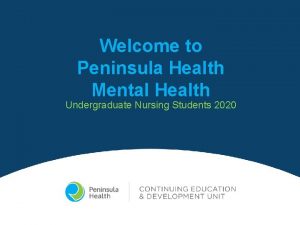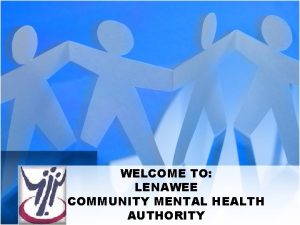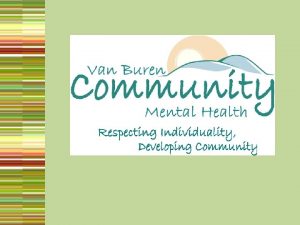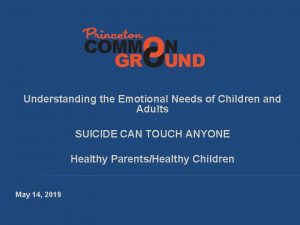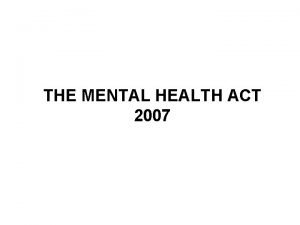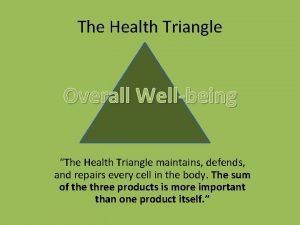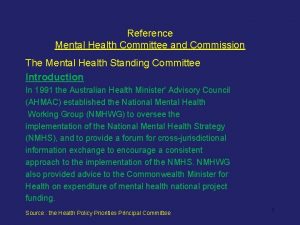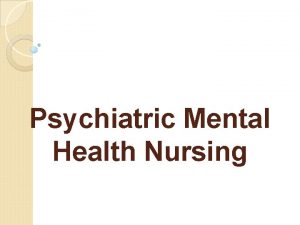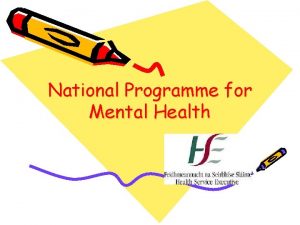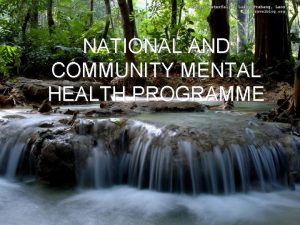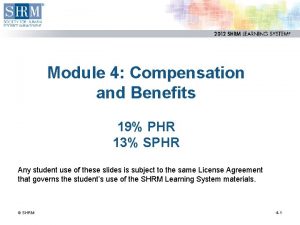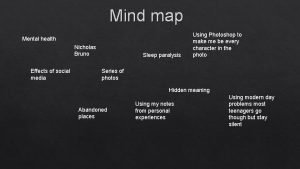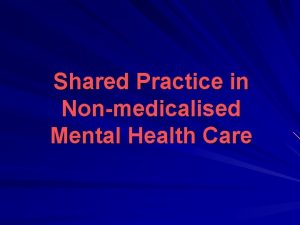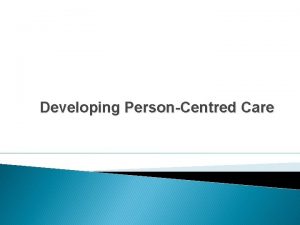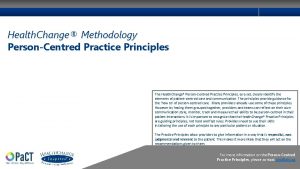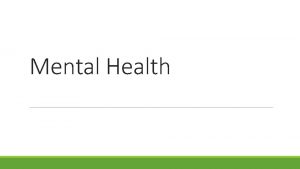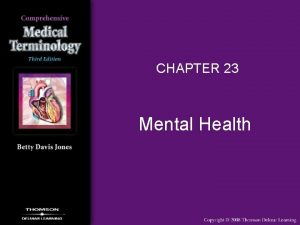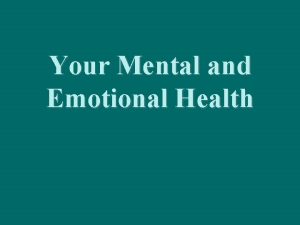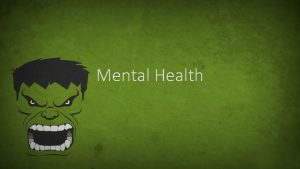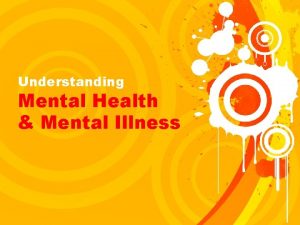PersonCentred Practice An expression of Nonmedicalised Mental Health




















- Slides: 20

Person-Centred Practice An expression of Non-medicalised Mental Health Care

The Person-Centred Approach Carl Rogers 1902– 1987 The approach has been in continuous development from circa 1935 to the present day

To be radically nice Rogers’ approach was radical because it started in entirely the ‘wrong’ place — it started with the client and the primacy of understanding the client’s process he thought that it was unhelpful to stereotype and categorise the client’s experience: he was set against diagnosis because it was damaging he thought that it was unhelpful to understand the client’s process as one of ‘sickness’ he thought it was unhelpful to play the expert, because he believed that it was the client who was the expert in their distress and their healing

To be radically nice it is helpful to be humble and authentic, to listen, understand accept rather than judge, interpret and categorise people are not ‘bad’, ‘dangerous’ or ‘flawed’. As adult human beings we do not have to be protected from ourselves humans are not limited to change by learning human beings grow. We live by growing and are constantly changing and adapting by growing. Clients grow in multi-dimensional ways which are frequently mysterious to therapist

To be radically nice John Shlien style ‘Diagnosis is not good, not even neutral, but bad. Let’s be straightforward and flat out about it, it is not only that its predictions are flawed, faulty, and detrimental to the relationship and the client’s self -determination, it is simply a form of evil. It labels and subjugates people in ways that are difficult to contradict or escape. ’

To be radically nice John Shlien style ‘There is no value in being ‘reasonable’, in wanting to participate in reformulation of the psychodiagnostic endeavor that will generate a universally agreed-upon answer. Why petition to be a partner to reformulation when it is wrong from the beginning? It does not pay to make even temporary concessions to logic you believe to be false, or professional conventions you believe unworthy. They haunt one forever. ’

How to be nice Try to understand the other person. Listen to how they experience their world. Help them find meaning in their experience. Feeling understood is helpful in itself. Do not interpret their experience, tell them what it means or impose your own meanings on it. They are the expert. If they ask you to explain their experiences, be straight with them.

How to be nice Accept the other person as a worthwhile human being. You don’t have to approve of their behaviour, but they are a human being of equal value. Some people have been damaged by harsh, heavy -handed opinion, unreasonable judgement or abuse. It’s important that they don’t get more of the same from you. Be positively warm and accepting of ALL aspects of the person, including those parts that want to choose an option that we don’t agree with.

How to be nice Do not have a front or facade, do not act like an ‘expert’, be your real self as a helper; fallible, vulnerable, imperfect, not knowing any of the answers. This goes against some of the training in the ‘helping professions’ which advises people to keep a professional distance, bluff it out, pretend they know what they’re doing (even if they don’t) and close ranks.

How to be nice Be ‘principled’ rather than ‘instrumental’ when you offer this relationship. Mean it, inhabit it, BE nice. Being nice is NOT a treatment or intervention. Understanding, acceptance and genuineness are not tools to get to the bottom of things, extract truths or flesh out symptoms. They are both the means AND the end. You will be found out if you don’t mean it.

Person-Centred: Growth Medical Model: Illness/Health Metaphors for distress Self-defined, described experience of distress Actualisation Diversity Changeable Sick, ill, damage, imbalance Treatment from outside the person Disability Immutable Vocabulary Potentiality Deficiency Authority (in therapy) Client Therapist Privileged professional discourse No ‘professional’ perspective trumps the client’s experience [There must be room for a ‘safety’ discourse, though] (In order of power) Psychiatrist Clinical psychologist Psychiatric nurse/ Social worker

Person-Centred: Growth Medical Model: Illness/ Health Power relations between client and practitioner [Note: ‘safety’ of self and others must also be addressed] Acknowledged, informed by dynamics of client as self-directing healer Reinforce personal power of client Informed by need for treatment compliance: predisposed to abuse Reinforce low structural and personal power of patient Nature and process of intervention Holistic Emphasises personal power of client Empathy Potentiality ‘Being with’ Description Reductionistic Diagnosis Instructional Correctional Reinforce deficiency model Prescription

Person-Centred: Growth Medical Model: Illness/Health Nature of distressed person Whole person Client/subject Director of healing process Represented by authentic experience Compartmentalised Patient/object Disenfranchised Represented by recognised symptoms Nature of therapist Companion, equal, nonexpert Expert; Physician Technician Privileged frame of reference Internal/the client’s experiences/the world of the client External/diagnostic framework/theory of psychopathology Change process Self directed Growth Actualisation Development Expert directed Repair Reprogramming Cure

Person-Centred: Growth Medical Model: Illness/Health Aim of intervention Fulfilment of potential Growth through and with current experience Treatment compliance Recover previous state of being (health) Return to homoeostatic balance Resources In a rich facilitative growthorientated milieu the client is able to make use of all possible resources, including the whole person of client Expertise of therapist Psychopharmacology Psychotechnology [Note client’s ‘whole person’ is frequently seen as a negative resource, an obstacle – they don’t call it ‘treatment resistance’ for nothing]

Medical metaphors for psychological distress – still think it’s a good idea? ‘Grief is not an illness; it is more usefully thought of as part of being human and a normal response to death of a loved one’ Editorial (unsigned) Lancet 18 Feb 2012 [In response to the BE being removed from DSM-5]

Non-medical metaphors for distress ‘Feeling low is not an illness; it is more usefully thought of as part of being human and a normal response to bad, hurtful or humiliating things happening to you. ’ Commonsense (and scientific evidence) … and Person-Centred

Non-medical metaphors for distress Being overwhelmed … Hearing voices… Having jumbled thoughts … Not wanting to get up in the morning, wash or eat regular meals … … not illnesses; they are more usefully thought of as part of being human and normal responses to …

The struggle for meaning in mental health professions … psychological treatments are so effective, only ethics and social action can save us

When everything we do has the same effect … use ethics Do we choose a helping method that is the cheapest? Do we choose a way of helping that treats people like machines, or tin cans? Do we choose a method that boasts the white heat of psychogeno-neuro technology? What will you choose?

When change is in the air … Be on the side of right • ‘Homosexuality’ • Menstruation, Pregnancy, Premenstrual Dysphoric Disorder Borderline Personality Disorder, Masochistic personality Disorder. (‘Being a woman’) • Learning disability CURED! (Well, almost!) CURED!
 Mental health and mental illness chapter 20
Mental health and mental illness chapter 20 Mental illness mental health jeopardy
Mental illness mental health jeopardy Quadratic equation
Quadratic equation Yparc frankston
Yparc frankston Lenawee community mental health authority
Lenawee community mental health authority Van buren cmh
Van buren cmh Intentional use of unfriendly or offensive behavior
Intentional use of unfriendly or offensive behavior Together for mental health
Together for mental health Mental health act 2007
Mental health act 2007 Well being triangle
Well being triangle Titles for mental health presentation
Titles for mental health presentation Health committee introduction
Health committee introduction Public mental health
Public mental health Mental health nursing define
Mental health nursing define Conclusion of nursing process
Conclusion of nursing process Mental health programme
Mental health programme Objectives of community mental health
Objectives of community mental health Mental health equity
Mental health equity Photoshop mind map
Photoshop mind map 2016494500
2016494500 Mental health safety talk
Mental health safety talk



